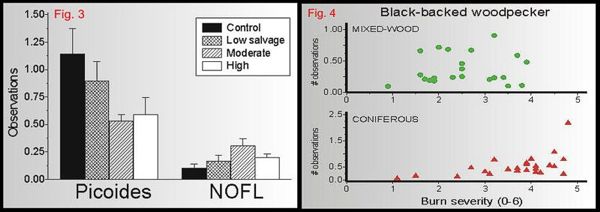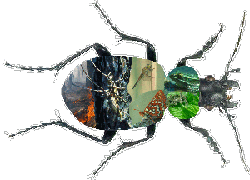
THE HOUSE RIVER FIRE PROJECT
Matti J. Koivula
The House River Fire Project is a study on the ecological effects of post-fire logging, fire severity and spatial scale in boreal mixedwood forests.
A joint project with four institutions
- University of Alberta (U of A; birds, beetles, vegetation, live & dead trees)
- Alberta Research Council (ARC; dead wood and lichen inventories)
- Alberta-Pacific Forest Industries Inc. (AlPac; field-work funding and practical arrangements)
- Canadian Wildlife Service (CWS; song-bird inventories)
The principal investigators in the U of A are Dr. Matti Koivula, Prof. Ellen Macdonald, Prof. Fiona K. A. Schmiegelow and Prof. John R. Spence.
History

Fire is one of the most important natural disturbances in boreal forests. In addition to initiating the primary succession, fire also creates temporary food, habitat and shelter resource for various forest organisms. In managed forests, these processes are often disrupted by salvage logging, i.e., post-fire removal of merchantable timber.
In Alberta, the annual burned forest area is usually less than 2000 sq-km but varies greatly (between 0 and 14,000 sq-km during 1960-2000). The House River fire, which burned in May 2001, covers almost 3000 sq-km of forest. The area was not homogeneously burned, as e.g. weather, topography, forest type and habitat-type variability affected the fire intensity and resultant patchiness in burn severity.
Apart from increasingly efficient fire prevention, much of the burned forests have been salvage harvested since 1990s. The reasons for post-fire salvage logging are threefold: (1) to promote tree growth, (2) to decrease the risk of future fires in the area, and (3) to recover some of the economic losses due to the fire (see e.g. Nappi et al. 2004 / Forestry Chronicle). The former two have recently been questioned by Donato et al. (2006 / Science), which has raised a rather bitter debate on the salvage issue (see e.g. The Scientist). However, most of the ecological effects of salvage logging have not been evaluated. The House River Fire project aims at fulfilling the knowledge gap on salvage logging and burn severity, and on how these affect the boreal fauna and flora.
Sampling
The field work was done during 2003-04. Our design included 24 large (625 ha each) landscape units (Fig. 1). These represented
- low (7-15 percent), and
- high (25-35 percent) levels of merchantable mixed-wood timber...
...and were further divided into four logging treatment classes:
- control (0 percent cut)
- low logging intensity (20-30 percent of merch logged)
- moderate logging intensity (40-50 percent)
- high logging intensity (60-70 percent)

Birds were inventoried applying triangle transect counts (1.5 km per side; Fig. 2) eight times between early May and mid-July. We also carried out winter bird counts during February-March 2004 using the same transects.
Insects were collected at eight mixedwood stands (at least 200 m apart) in each landscape unit (red dots in Fig. 2). Each stand had two sampling points 25-50 m apart. Each sampling point had one window trap placed on a White spruce tree, and two pitfall traps at 2-m radius from that tree. The sampled stands were selected proportionally to the landscape-level logging intensity. Thus, control landscapes (no harvesting) had all the 8 stands in unlogged, whereas in the logged landscapes traps were placed into clear-cut and unlogged stands in the following proportions: low harvesting 2/6, moderate 4/4, and high 6/2.
Vegetation was inventoried using three protocols (partly shown in Fig. 2). First, the immediate surroundings of each pitfall trap were described by recording the abundance of dominant plant species and site structural characteristics. Second, vegetation was inventoried in more detail (all species recorded) in selected burned-not-logged and burned-then-logged sampling points. Third, vegetation was inventoried in 2004 in Black spruce stands to study whether these could act as secondary (or life boat) patches for mixedwood-forest plants over the early post-fire succession.
Dead wood and live trees were inventoried at a 8 x 8 m area around each insect-sampling point (Fig. 2). In 2004, we also carried out dead-wood inventories in every stand >1 ha along some bird-count transects to study the presence of woodpecker and beetle signs on trees in various types of forest habitat and the variation in dead-wood quality and amount. Also, ARC carried out detailed dead-wood inventories at each sampling point in 2003 and in 2004.
The below analyses were done at the landscape-unit level using standardized data subjected to General Linear Models (GLM) and Non-metric Multidimensional Scaling (NMDS). The GLM had salvage and merchantable timber levels as factors, and burn severity (estimates based on tree survival sensu Hutto (1995 / Cons. Biol.)). The NMDS was based on Bray-Curtis similarity matrix. For bird analyses, mixed-wood and coniferous (Jack pine and Black spruce; not salvaged) were analyzed separately. The analyses were done using the free R software.
Results
Birds

The bird data consisted of over 50,000 observations (140 species). The summer woodpecker data alone included 3,309 observations on seven species. The winter survey with only 3 rounds in 23 landscape units produced additional 461 woodpecker observations (five species).
The woodpecker data (limited to observations made within mixed-wood areas) indicated negative effects of salvage logging on woodpeckers of the genus Picoides whereas Northern flicker (Colaptes auratus; NOFL) showed a significant (p <0.05) positive response (Fig. 3). The community-level NMDS for woodpecker data did not indicate marked changes due to salvage logging (not shown).
Three passerine species showed significant negative responses to salvage logging: Tennessee warbler (Vermivora peregrina), Brown creeper (Certhia americana) and Yellow-rumped warbler (Dendroica coronata) (graphs not shown). None of the 15 most abundant forest species showed positive responses to harvesting. However, salvaged areas still hosted most of the passerines, and their unadjusted species richness was not lower than in non-salvaged areas, but the NMDS indicated that salvage logging may homogenize passerine fauna, which is indicated by the very tight scatter of salvaged sites (circled with blue in Fig. 5).

Burn severity was another highly significant abundance determinant for several bird species. For example, Black-backed woodpecker (Picoides arcticus) showed a significant positive response to increasing burn severity in coniferous areas, but the trend was less obvious in mixed-wood (Fig. 4). Mixed-wood areas may burn less severely than coniferous ones, at least when crown fires are considered.
Insects
The ground beetle data consisted of 26,744 specimens (67 species).
As with forest birds, only a few species showed positive responses to salvage logging, most notably Sericoda quadripunctata, a fire specialist (not shown). Moreover, salvage logging had a positive effect on ground beetle richness (Fig. 6) which is in accordance with several earlier studies done in harvested unburned forests. However, most of the abundant forest dwellers responded significantly and negatively to salvage; see two examples (Calosoma frigidum and Harpalus laevipes) in Fig. 7. Thus, the increased richness was apparently due to minor components in the fauna, such as colonizing Amara and other open-habitat associated species. It is noteworthy that none of the forest specialists had gone extinct due to salvage (even when data were analyzed at sampling-point level i.e. logged vs. unlogged stands), although these had decreased in abundance. Fire severity also significantly determined the abundance of several ground beetle species (both positive and negative responses; graphs not shown).
The window trap data identification is currently in progress (February 2006). To date, the first sampling period in 2004 produced ca. 5,000 specimens and 210 species.

Conclusions
Results summary: (1) salvage logging significantly changes the abundances of several abundant forest bird and ground beetle species; (2) salvage logging tends to homogenize the passerine bird fauna but increase the richness of ground beetle assemblages; (3) salvage logging also has positive effects on fauna (however mostly minor, regarding the abundant forest dwellers); and (4) within the fire perimeter burn severity is a highly significant abundance determinant of the abundance of several forest species.
The findings suggest that landscape-level planning of salvage logging is crucial for a better maintenance of forest organisms in the forested post-fire landscape. The positive response of the woodpeckers to fire severity may indicate that the most severely burned areas should be retained while salvaging; however, as many beetle species showed negative responses to both salvage logging and burn severity (e.g. Calosoma frigidum) also lightly burned areas should be retained to guarantee the resilience of forest fauna as a whole. Thus, the whole spectrum of different habitat types, along with the variation in burn severity, may after all appear crucial for the combining of conservation and management. From the forest biota point of view the more one retains the better; at least the retention patches should be of reasonable size i.e. at least several hectares and not be too scattered.

Acknowledgements
We thank our field crews 2003-04 (Delanie Player, Simon Slater, Lisa Best, David Bywater, Lynnette Dagenais, Derek Keeping, Becky Motuzas, Lynsey Mozak, Anne Ollila, Sabrina Romanchuk and Lisa Tidman), Dave Stepnisky and Dustin Hartley, Canadian Wildlife Service, Alberta Research Council and Alberta-Pacific Forest Industries Inc. MK was financed by the Izaak Walton Killam Postdoctoral Fellowship, University of Alberta.
Copyrights of the presented material: Matti Koivula, except Spence Lab beetle (bottom left) Joshua Jacobs
